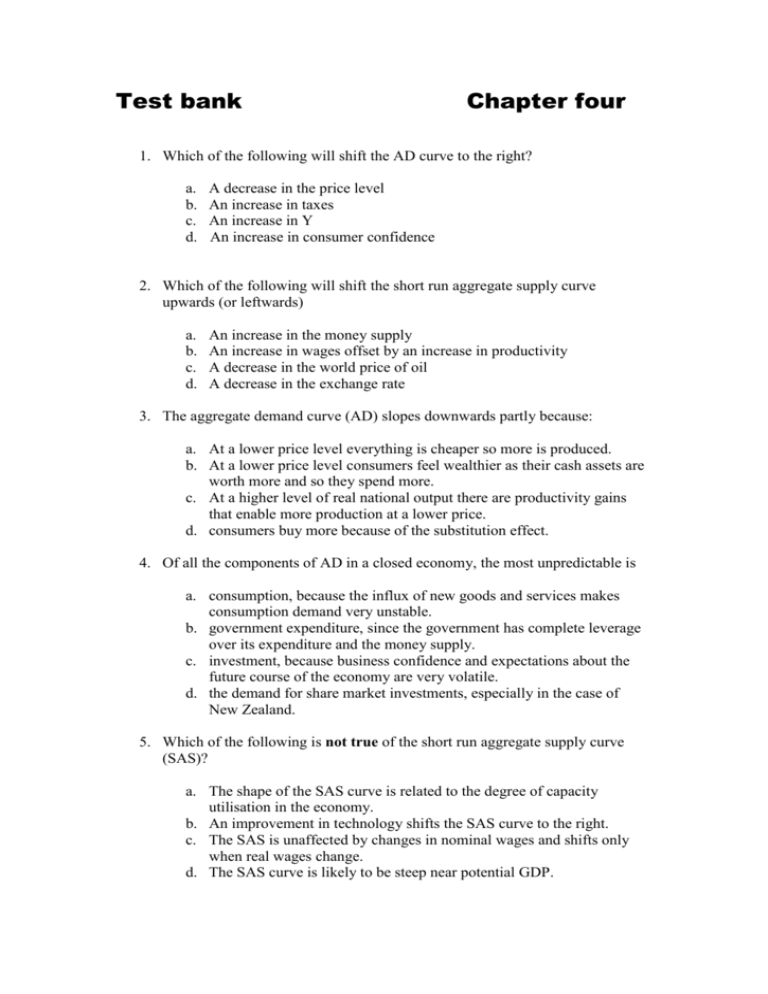Document
advertisement

Test bank Chapter four 1. Which of the following will shift the AD curve to the right? a. b. c. d. A decrease in the price level An increase in taxes An increase in Y An increase in consumer confidence 2. Which of the following will shift the short run aggregate supply curve upwards (or leftwards) a. b. c. d. An increase in the money supply An increase in wages offset by an increase in productivity A decrease in the world price of oil A decrease in the exchange rate 3. The aggregate demand curve (AD) slopes downwards partly because: a. At a lower price level everything is cheaper so more is produced. b. At a lower price level consumers feel wealthier as their cash assets are worth more and so they spend more. c. At a higher level of real national output there are productivity gains that enable more production at a lower price. d. consumers buy more because of the substitution effect. 4. Of all the components of AD in a closed economy, the most unpredictable is a. consumption, because the influx of new goods and services makes consumption demand very unstable. b. government expenditure, since the government has complete leverage over its expenditure and the money supply. c. investment, because business confidence and expectations about the future course of the economy are very volatile. d. the demand for share market investments, especially in the case of New Zealand. 5. Which of the following is not true of the short run aggregate supply curve (SAS)? a. The shape of the SAS curve is related to the degree of capacity utilisation in the economy. b. An improvement in technology shifts the SAS curve to the right. c. The SAS is unaffected by changes in nominal wages and shifts only when real wages change. d. The SAS curve is likely to be steep near potential GDP. 6. The SAS curve slopes upwards near full employment because: a. b. c. d. Wages rise as firms compete for employees. It becomes more costly to produce extra output with fixed capital. Consumers are willing to pay higher prices for market output. Spare capacity allows more output to be produced without raising prices. 7. Which of the following combination of events would shift both the SAS curve and AD curve outward (to the right)? a. The price of imported oil falls and government cuts expenditure on defence. b. Worker productivity rises, and is rewarded with a wage rise. c. Wages fall, and the government reduces income taxes. d. Business confidence rises and exports increase. 8. Increasing government spending is most effective in increasing real GDP when: a. b. c. d. There are large wage increases There is a high demand for imports It is accompanied by a decrease in the money supply The aggregate supply curve is flat. 9. The self-correction of a recessionary gap may occur if: a. Unused industrial capacity allows firms to expand output and raise prices. b. Unemployed labour puts downward pressure on wages. c. Government responds by increasing government spending or lowering taxes. d. The aggregate supply curve shifts inwards to intersect the aggregate demand curve at the level of full employment GDP. 10. Deflation may be the result of all but which one of the following a. A rapid fall in confidence and cuts to wages b. An outward shift of the SAS due to productivity advances not offset by rising demand. c. A rapidly decreasing exchange rate and static aggregate demand d. Better technology and economies of scale in production






